The big pupil should get back to normal in a vew days. Behind it, not visible, is a new lens. Now I can see to read, look at photos, graft, pollinate, type, write,look at bees and bugs, and do a lot of other things that work better with 2 working eyes. The right one was like looking through wax paper.
Science and technology can be wonderful, sometimes.
Que in Pharrell Williams, "Happy".
Monday, January 05, 2015
Thursday, January 01, 2015
More on Bagging Fruits for Protection. 1.1.15
This is my momentary obsession for gardening. It will pass. Something to read and learn during winter. Meanwhile, some references.
oisat.org describes how to make fruit bags from newspapers. I can see that working in dry climates, or summer fruit in dry summer areas, such as here. "works well with melon, bitter gourd, mango, guava, star fruit, and banana" "...prevents insect pests, especially fruit flies, from finding and damaging the fruits. The bag provides physical protection from mechanical injuries (scars and scratches) and prevents female flies' laying activities, latex burns, and fungal spots on the fruits. Although laborious, it is cheaper, safer, easier to do, and gives you a more reliable estimate of your projected harvest." They use double layers of the newspapers and sew or stable them to make the bag.
oisat.org describes how to make fruit bags from newspapers. I can see that working in dry climates, or summer fruit in dry summer areas, such as here. "works well with melon, bitter gourd, mango, guava, star fruit, and banana" "...prevents insect pests, especially fruit flies, from finding and damaging the fruits. The bag provides physical protection from mechanical injuries (scars and scratches) and prevents female flies' laying activities, latex burns, and fungal spots on the fruits. Although laborious, it is cheaper, safer, easier to do, and gives you a more reliable estimate of your projected harvest." They use double layers of the newspapers and sew or stable them to make the bag.
Detailed discussion for various fruits, on Hawaiifruit.net. They used manufactured bags of various types from Japan. It's interesting, they note " For hundreds of years throughout most of Asia, farmers have
been covering fruit with paper either to protect their appearance or to
increase the time the fruit would be on the tree thus making it sweeter." and "This practice first came to Hawaii with the early Japanese
immigrants and in the 1920’s Ohau farmers employed school children to
wrap figs." They describe their experiment showing of the first 100 bagged figs, 94 were harvested undamaged. Six were damaged, thought due to rats. Of 100 unbagged fruits, 86 were damaged beyond recognition by birds.
Because of the bird damage, insect damage was not possible to assess.
The Hawaii article discussed multiple varieties of fruit. The only ones I can grow from their list, are figs.
From rfcarchives.org.au, "In Japan where the average orchard is only two to three acres, bagging
is an important cultural operation for fruits such as loquat, persimmon
and nashi fruit (Asian pear). ... bagging is
undertaken to reduce the number of pesticide applications and to improve
fruit appearance.. provides a major defence against
fruit piercing moths ...makes po ssible the production of fruit of a very attractive
blemish-free fruit with considerable eye appeal." Some of the bags in Japan are impregnate with pesticide, something I won't do. The article goes on to state bag are used for mangos in the Philippines. Among the types of bags, newsprint was one type that worked well to dramatically reduce insect damage. Plastic bags did not work well in their work with mangos. On the same website, one writer used nylon bags made from old curtains, with successful protection of the fruit (1983).
This article on pears, did not describe insect damage, but rather lack of negative changes in pears due to bagging. "
Preharvest bagging of pear fruit (Pyrus communis L. ‘Doyenne du
Comice') with micro‐perforated polyethylene bags c. 30 days after full
bloom did not affect fruit size and weight, density, maturity, and flesh
content of N, P, K, Ca, and Mg. Bagged fruit had a greener and lighter
skin colour than non‐bagged fruit, whereas the development of blush on
the sunny side was not different between treatments"
Apparently, bagging can also be beneficial for persimmons.
What interests me here is that, in so many years of gardening, I haven't read about bagging fruits. I'm sure the method will not benefit all fruits, in all climates, but it looks like it's worth testing for apples and a number of other fruits. It's surprising the method has been around so long, and so widespread, and yet is not part of the general gardening knowledge here.
Edit: Adding more articles. In Sicily, in the province of Enna, peaches are bagged in parchment paper bags. The resultant peaches are called "Pesca Settembrina". A farmer came up with the bagging method in the 1960s to save peaches from the Mediterranian Fruit Fly. Also "The pulp firmer and more acidic, due to the slow maturation, make it particularly suitable for the preparation of jams; are excellent in combination with the white meat which give it a special taste."... " The remedy comes a few years later: the parchment paper bag in which the fruits are wrapped 120-150 days before fully ripe peaches protects from pests, from the weather and avoid the excessive use of fertilizers from industrial sources."
Edit: Adding more articles. In Sicily, in the province of Enna, peaches are bagged in parchment paper bags. The resultant peaches are called "Pesca Settembrina". A farmer came up with the bagging method in the 1960s to save peaches from the Mediterranian Fruit Fly. Also "The pulp firmer and more acidic, due to the slow maturation, make it particularly suitable for the preparation of jams; are excellent in combination with the white meat which give it a special taste."... " The remedy comes a few years later: the parchment paper bag in which the fruits are wrapped 120-150 days before fully ripe peaches protects from pests, from the weather and avoid the excessive use of fertilizers from industrial sources."
Labels:
apple bagging,
apples,
figs,
fruit bagging,
pears
Learnings. What went well, what didn't. What I obsessed over. 2014. 12.30.14
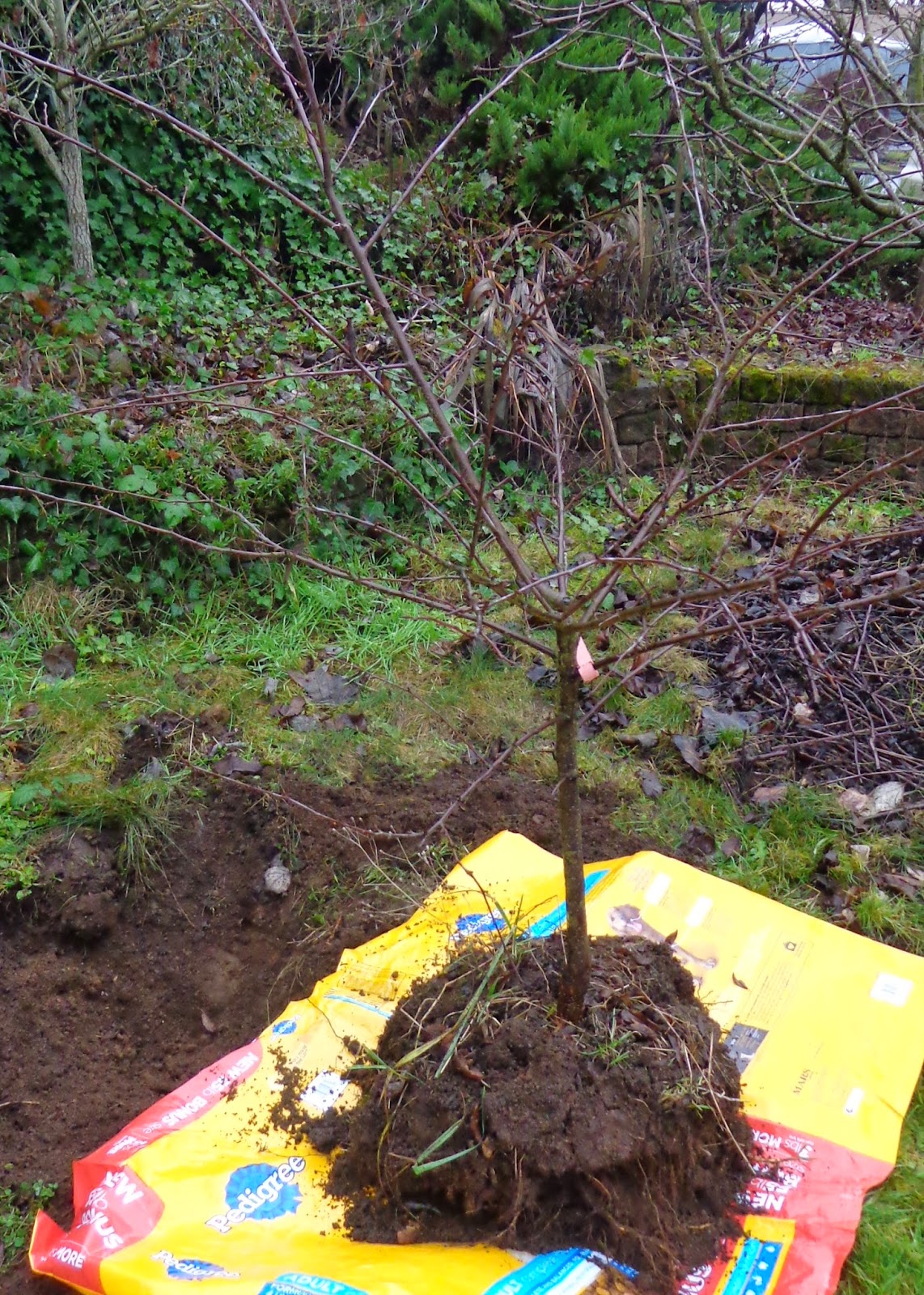 |
| Transplant Methley Plum. Jan 2014 |
Transplanted Methley plum tree in January. It did fine, but no plums this year. January is a good time to transplant around here, if the roots are good and the weather is mild.
Lilacs are really easy to propagate by digging up suckers, pruning them off, and replanting. All survived. Again, dug them in January. All of the starts grew moderately and developed good root systems.
Covering the raised beds with plastic increased the temp, allowing for cold season vegetables to grow in February.
Embossable labels work better than any other type of label.
Pepper plants started about Jan were the first to bear. They do not have to be started that early, but it was nice to get early peppers.
Whip and tongue grafting is easy and awesome. That was the end of Feb. All of the pears, and all of the apples, took. Few or none of the lilacs took. Lilacs are more challenging to graft. I still don't have a foolproof method for them.
It was easy to dig up and transplant daffodils and Hyacinthoides right after they started to grow in March. All survived and bloomed. It was a great way to have some instant spring blooming bulbs, not planted the fall before. Not really instant but seemed that way. Waiting until the foliage dies is probably better, but there is so much going on then, I forget.
The indoor plant growing light was easy, cheap, and worked very well. I have it set up again for this winter's seedlings.
Learnings for the little orchard: Deer were the most destructive and frustrating challenge. They ate cherry trees, to the point of almost killing the trees. I already had the plum trees fenced, so they were OK. They ate a few peach branches, not a lot. Similar for persimmons. Something - maybe a rabbit - ate off one pawpaw sapling, so all got caged. As of now, all cherries are caged, all pears, apples, plums, pawpaws, persimmons. Two trees died - Satsuma plum and Korean Dogwood. I think that's because I did not get the roots unwound from the containers. Another thought, is voles, but on the tree autopsy I did not see eaten roots. Lesson learned - get those root systems spread out. I already knew that but did not practice it in those cases. Hollywood plum was very easy to start from cuttings - all grew. Shiro plum did not grow at all from cuttings. With hand cross-pollinating, the Asian pears had heavy yields, really productive, for the first time ever. By grafting pollinating varieties within each pear tree, I hope the pollinating is easier in the future. But I really didn't mind doing it. Enjoyable. I have almost every tree in a fencing circle to reduce or prevent deer browsing next year. Lesson learned - install the fencing at the time the trees are planted, even before planting. Then it is done, and you don't wind up saying "I wish I did that".
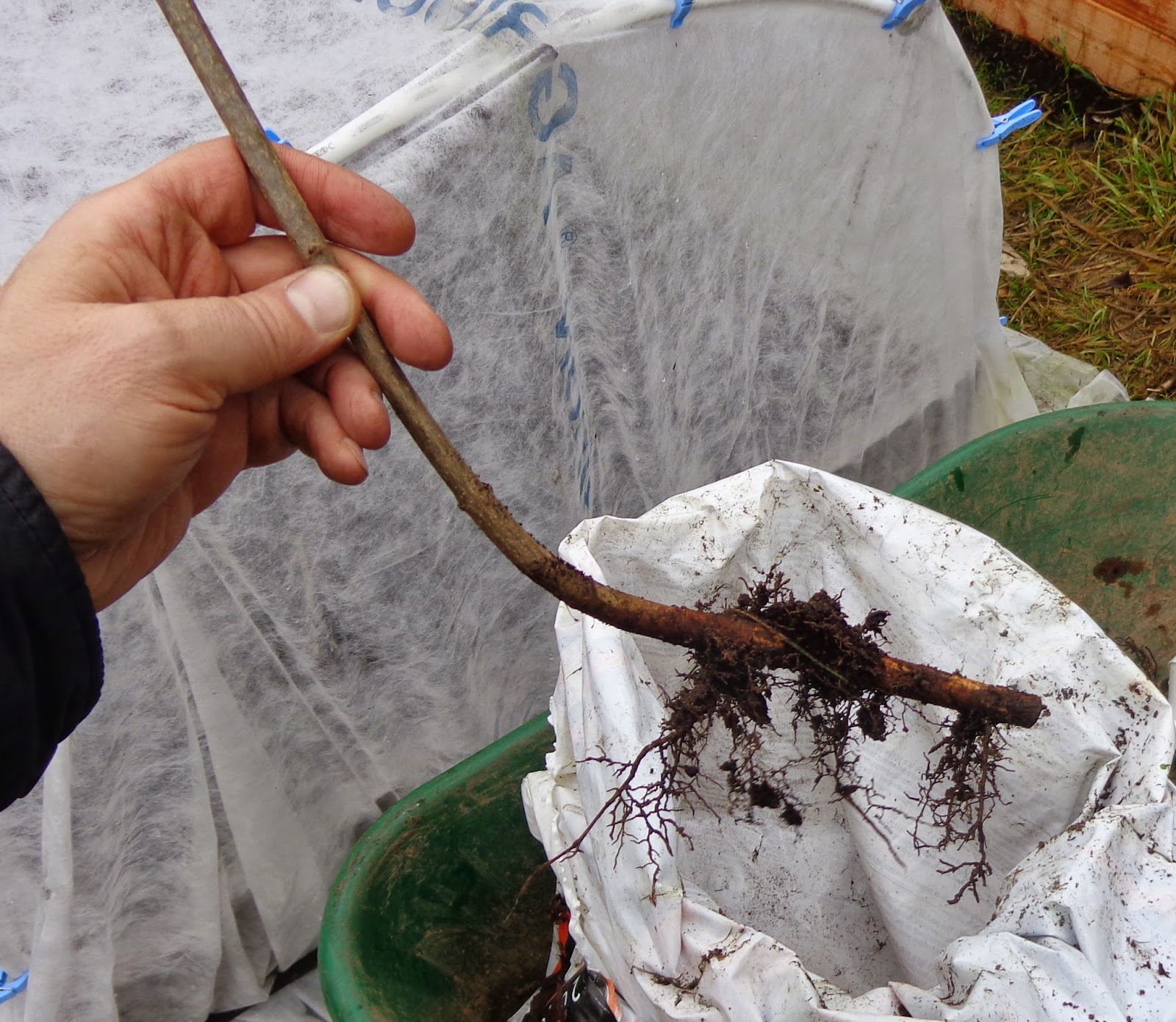 |
| Lilac Propagation via Suckers. Jan 2014 |
 |
| Covered Bed. Feb 2014 |
 |
| Pepper plants, 2.1.14 |
 |
| Asian Pear - Whip and Tongue Graft. 2.25.14 |
 |
| Apple. Whip and Tongue Graft. 2.25.14 |
 |
| Bulb transplants. 3.2.14 |
| Plant light project. 3.2.14 |
The bearded irises were very frustrating. Big, very frustrating, losses from bacterial rot. Almost every plant had at least some rot. A few were completely killed. May have been due to too much nitrogen the fall/winter before. Lesson learned. No nitrogen boost this time around. Also no ground covers, although weeds are challenging for bearded iris. We'll see if they do better this time around.
Lilacs did great this year. It's nice to have several types. Now I have starts from 5 colors, at the Battleground place. Bud grafting was about 30% successful on lilacs. Maybe - we'll see if they grow.
Bud grafting is also awesome. Some of the early bud grafted plums grew rapidly. The later ones, healed but I will not know if they grow, until Spring. All of the plum bud grafts look like they took. About 75% of the cherries look good. Not sure about the peaches, and the lilacs may have a few.
The buddleias were a mixed bag. The "Cobbler" varieties - Peach Cobbler and Blueberry Cobbler - grew huge. That was OK in that location, they will be a bit of a windbreak. The flower heads are also huge. They start blooming from the bottom, and work to the top. That means, most of the time half of the flower is brown and dead, before the rest is done blooming. The result is an ugly bush. The "Miss" varieties - Miss Molly and Miss Ruby - those have smaller flowers, and less of the half dead/half blooming issue. They are more compact. Neither the Cobbler varieties, nor the Miss varieties, attracted honeybees, but they were good for bumblebees. The Honeycomb variety was newer, I'm not sure about that. The Blue Mist variety stayed more compact, the flower heads were small and much less of the half-dead aspect, looked very nice and the honeybees liked it.
Peecycling was the big lesson this year. Excellent source of nitrogen. Our water bill decreased due to not flushing it down the drain. Tomatoes were the most productive ever. Peppers did excellent. Lindens grew their most lush ever. Negatives, leaves on some buddleias, and laburnum, were curled. I used moderately on the Bearded Irises, and that may have been the issue with the bacterial rot. Possibly too much on those. I would not use on pear trees - they grow too fast, and lush growth is susceptible to fire blight. Sourwood also had a touch of fireblight, but recovered and grew nicely. I think this concept is mostly a "guy thing". We have been saving all of the at-home pee for the garden, and it was very lush in 2014, the best ever.
| Plant light project. 3.2.14 |
 |
| Orchard. 4.6.14 |
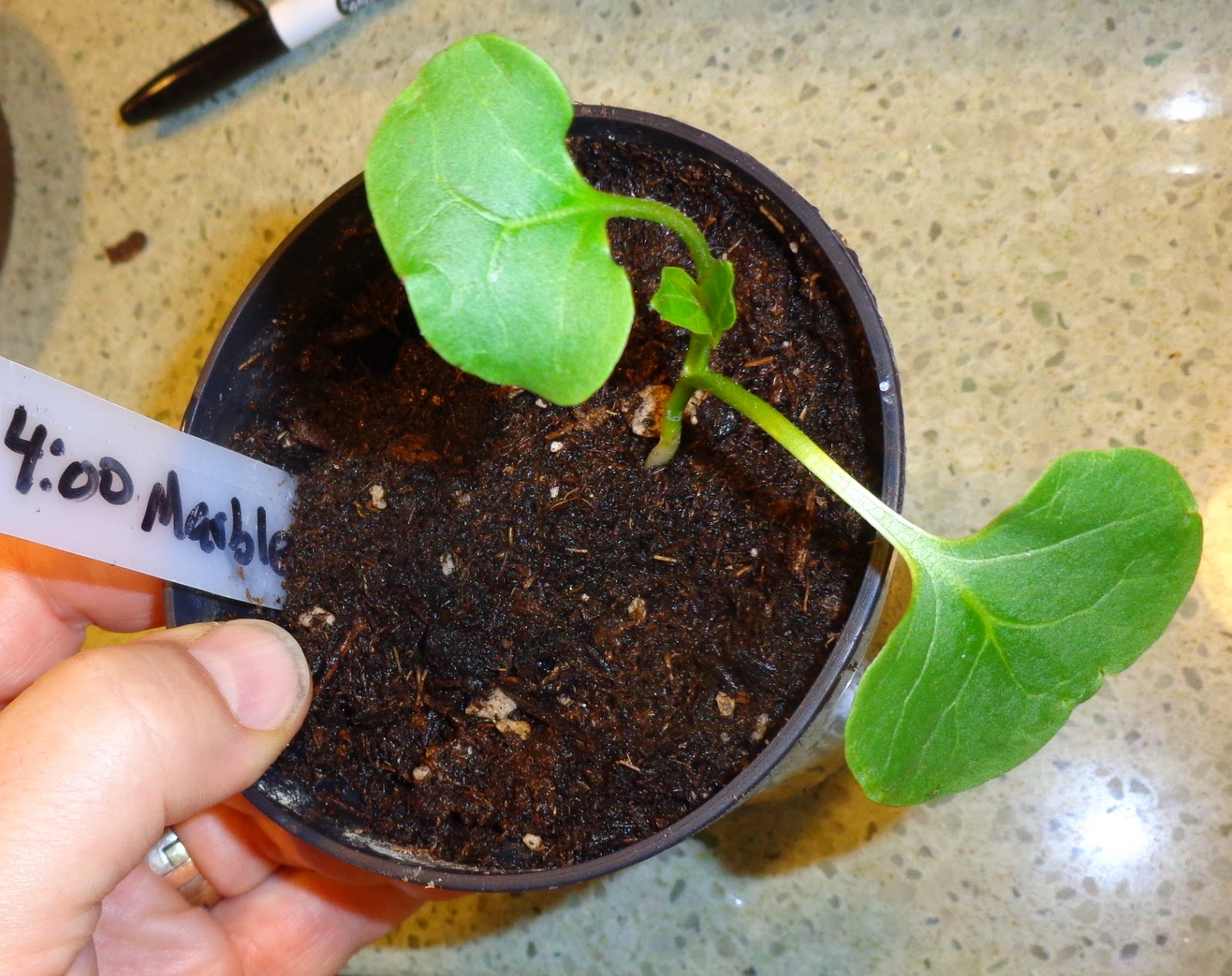 |
| 4:00 seedling. 4.6.14 |
The persimmons and pawpaws did respond to the nitrogen boost. I would not do that for mature trees, but it might be good for getting them larger, faster.
I still have a lot to learn about growing okra in this cool maritime climate. The container okras did much better than last year's in-ground okra. The varieties, "Burgundy" and "Baby Bubba" did best. They are hard to grow in sunroom due to attracting aphids. It helps to soak seeds over night, and pre-sprout on moist paper towel / zipper sandwich bag / on seed sprouting warming mat. Contrary to info on many websites, okra is easy to start in containers. You just have to be careful to slide them out of the container without damaging roots, when transplanting. More to learn, but so far, so good.
This as a lot of learnings in 6 months. Most of it went well. I tend to forget the unsuccessful things. The uncertainties to carry over to next year, mainly working on other herbivore control fencing, seeing if bearded irises will be free of bacterial rot, getting more okra in containers. I plan to move more bulbs in March after they start growing, as I did last year. Good to know that works. Lilac starts are now in their permanent locations. Much more grafting this year, based on last year's learnings.
 |
| Historic lilac bed. There were some good flowers despite a bacterial rot epidemic. |
 |
| It' nice having multiple varieties of lilacs. The different colors make for a beautiful bouquet. |
 |
| This was my first try for camassia. Very nice! |
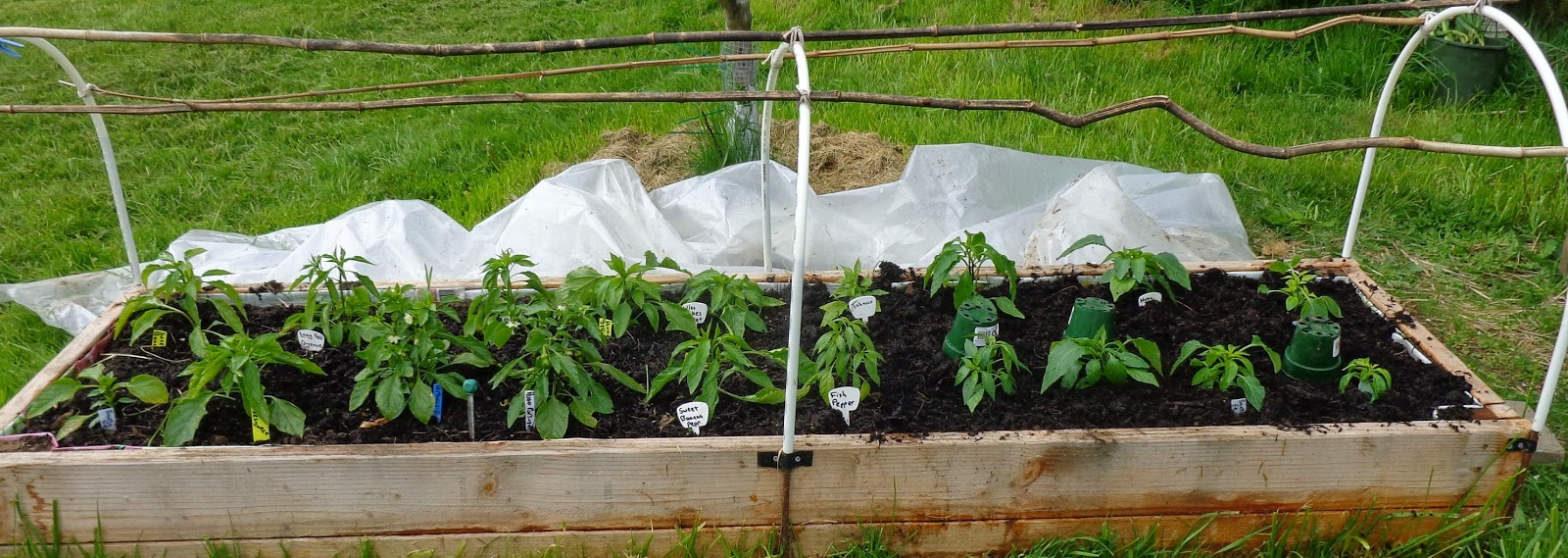 |
| Pepper bed worked out really nice. The cover kept them growing before the weather warmed up. Covering also prevented herbivory. |
 |
| Potato "wells" were OK, not great. Not sure if I will do that this year. |
 |
| Freeze killed figs grew back from the roots. |
 |
| Okra was OK in containers. Not lush like southern grown okra, but there was enough for some soups. |
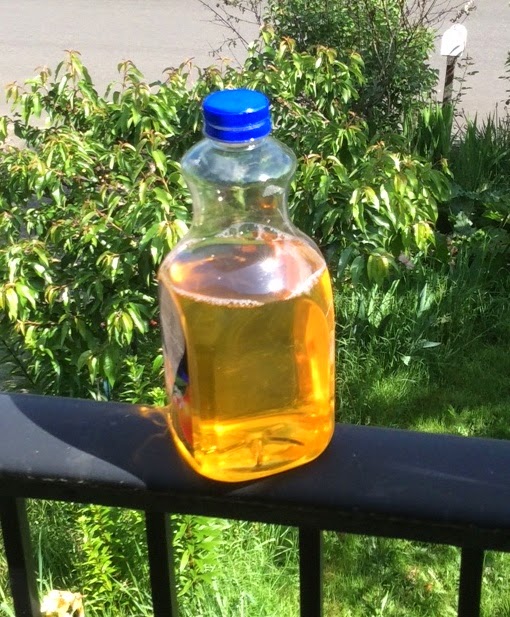 |
| Peecycling was a big new lesson. We got excellent results. |
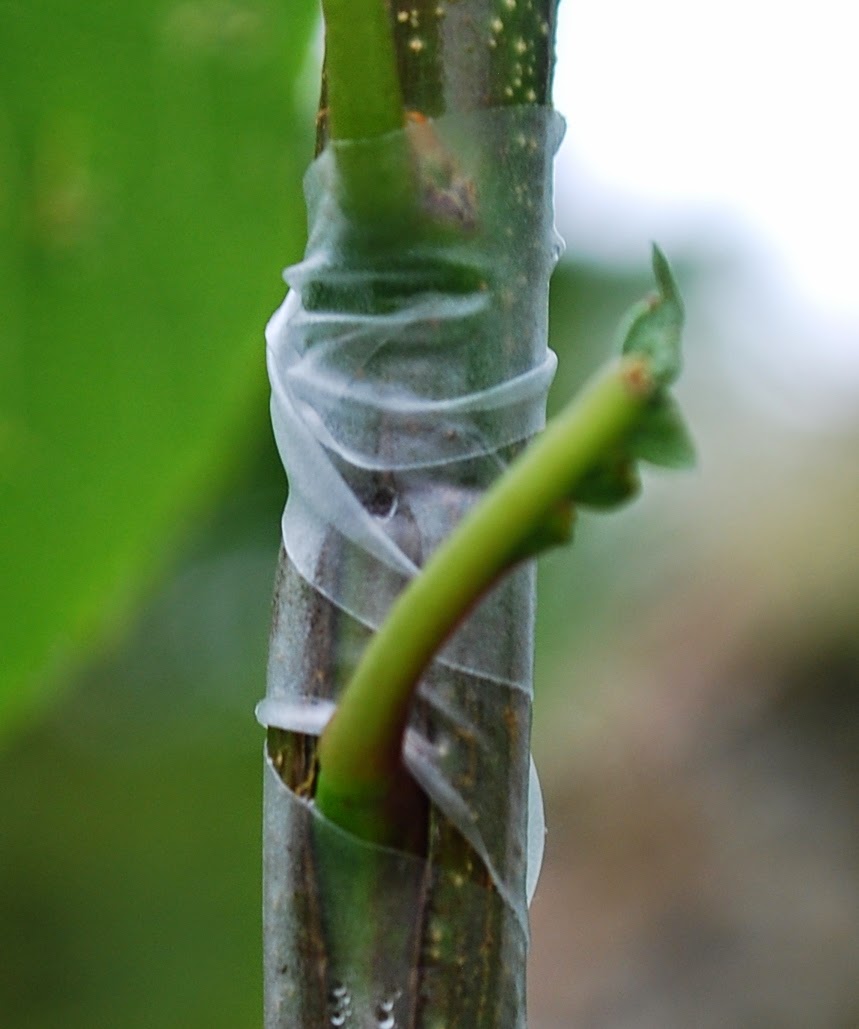 |
| This plum bud graft took and grew rapidly. |
 |
| Four O'Clocks were a new experiment. They were great! |
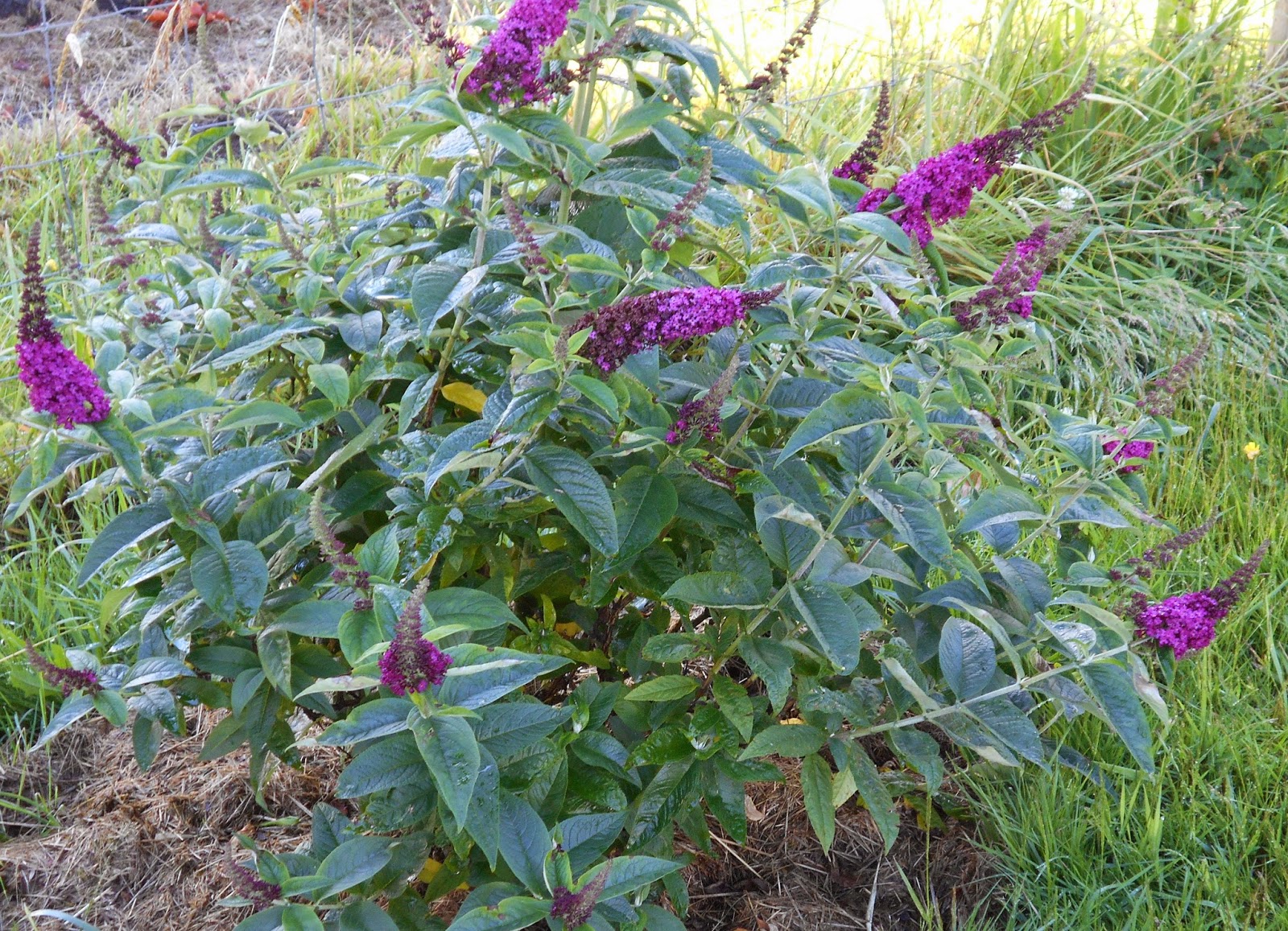 |
| Buddleia Miss Ruby was good. Compact and a nice bloomer. |
Sunday, December 28, 2014
Puttering. Training Young Fruit Trees. 12.29.14
 |
| Peach Variety Q-1-8 undergoing training. |
These were all growing together in a bunch. I tied them to the deer fencing, bending branches to make a vase-shaped tree. After one year, they can be untied.
I did the same for other trees, peaches, persimmons, pears, plums. I did the same for apples, too.
It doesn't look like much. The good training will make a big difference in a few years.
Propagating an oriental poppy. 12.29.14
 |
| P. orientale root divisions. 12.27.14 |
Back to the oriental poppy, P. orientale, these were raised by seeds planted 13 years ago. They became a big clump. I wanted to move it to the Battleground border. When I dug it up, it separated into big roots, like horse radish. This has been a mild winter. They have soem green leaves even now.
They are already dug up. I separated and planted each root section. If they grow, they grow. If not, I know this doesn't work.
 I did read that oriental poppies can be propagated via root cuttings. Image is this poppy clump, Ma 22, 2013.
I did read that oriental poppies can be propagated via root cuttings. Image is this poppy clump, Ma 22, 2013.
Saturday, December 27, 2014
Winter Project: Apple bags. 12.17.14
I haven't had as much success as I would like, with apples. I get them to the point where lots of apples are forming. Then a lot go to pot. Distorted, wormy, shrunken apples. Liberty is pretty good, not much disease or insect damage. North Pole, one of my older trees with lots of apples, almost never yields an edible apple. They are distorted and gnarled looking. Jonagold, very few usable apples. I got a good apple from my tiny Golden Sentinel apple last year.
The issue is disease and insect related. From what I read, commercial orchards spray and spray and spray and spray. Even organic orchards have their organic sprays. I've been trying my backyard apples with no spray.
Reading about the options, some gardeners insert each developing apple into a modified ziplock bag. The bag serves as an impermeable shield against most insects and disease. The result is a vastly improved yield of edible, supposedly perfect, apples. An added benefit, they ripen 2 weeks earlier. Some gardeners staple the bags in place. Others think that is not needed. One writer refers to this as a "Ziplock® Orchard"
The concept of bagging apples is common in Japan, where a large fraction of the crop is bagged. They use opaque bags, which must be removed to allow color formation and ripening. They also apply stencils, which prevent color formation under the design, resulting in a yellow tattoo on a red apple. The Japanese apples bring a high price premium, but it is happening less now because of the labor involved. Young rural Japanese people have other things to do, than bag apples. Prior to use in Japan, in the past century apples were bagged in France.
The apple bags are super easy and quick to make. A box of sandwich-size zipper bags costs a couple of dollars, generic. Mine came to a little over 1 cent per bag.
Use a sharp scissors. Cut the 2 bottom corners, for drainage of any water that leaks into the bag.
Cut off the top flaps, because the zipper will go around the apple stem. Most stems are too short to accommodate the top flaps. Open the bag before cutting the flaps, or it's a trial to get open.
I prepared 200 for next spring, then put them in my gardening cabinet. Spring is busy, better to make them now. I doubt I'll need anything near 200, but there they are.
From the articles I read -
#The bags do not result in overheating the apples. But the apples do wind up larger and ripen about 2 weeks sooner.
#Insects and disease do not enter through the cuts. Rarely an insect enters around the stem.
#Some apples might have a not-perfect smudgy appearance. That is not clear - the same author stated, so did their non-bagged apples.
#The bags must be applied very early - just after petal drop. Thin the fruit at the same time. If applying bags when the apples are larger than, say, a dime, then some insect and disease damage may be beginning, and you are locking the barn door after the horse was stolen.
#Based on my readings, bags work for solid fruits, like apples, pears, quince. But not for soft fruits, like peaches and plums, which may rot.
#The bags are not 100% effective, and work better in some climates than others. Where they do work, they are much cheaper than spraying. It's possible the bags are less effort than repeated spraying, especially with dwarf trees - no ladders. With bags instead of sprays, you are not indiscriminately killing both harmful and beneficial insects by spraying everything, especially since multiple sprays seem to be needed. So, both carnivorous insects, and pollinating insects both live to do their important jobs, and you can promote a beneficial garden ecosystem.
#Other types of bags, such as paper, are more trouble. Rain and wind are more damaging to paper bags. The bags must be removed for fruit to color properly.
#The zipper bags can be left on the fruit for storage. According to my readings, the fruit will last longer than non-bagged fruits.
#I wonder if paw paws would ripen a couple weeks earlier too? If mine set this year, I might try.
So this project is done. It will be summer before I know if it works. I have not done this before, so I can't vouch for the method. Several writers swear by it.
The issue is disease and insect related. From what I read, commercial orchards spray and spray and spray and spray. Even organic orchards have their organic sprays. I've been trying my backyard apples with no spray.
Reading about the options, some gardeners insert each developing apple into a modified ziplock bag. The bag serves as an impermeable shield against most insects and disease. The result is a vastly improved yield of edible, supposedly perfect, apples. An added benefit, they ripen 2 weeks earlier. Some gardeners staple the bags in place. Others think that is not needed. One writer refers to this as a "Ziplock® Orchard"
The concept of bagging apples is common in Japan, where a large fraction of the crop is bagged. They use opaque bags, which must be removed to allow color formation and ripening. They also apply stencils, which prevent color formation under the design, resulting in a yellow tattoo on a red apple. The Japanese apples bring a high price premium, but it is happening less now because of the labor involved. Young rural Japanese people have other things to do, than bag apples. Prior to use in Japan, in the past century apples were bagged in France.
The apple bags are super easy and quick to make. A box of sandwich-size zipper bags costs a couple of dollars, generic. Mine came to a little over 1 cent per bag.
Use a sharp scissors. Cut the 2 bottom corners, for drainage of any water that leaks into the bag.
Cut off the top flaps, because the zipper will go around the apple stem. Most stems are too short to accommodate the top flaps. Open the bag before cutting the flaps, or it's a trial to get open.
I prepared 200 for next spring, then put them in my gardening cabinet. Spring is busy, better to make them now. I doubt I'll need anything near 200, but there they are.
From the articles I read -
#The bags do not result in overheating the apples. But the apples do wind up larger and ripen about 2 weeks sooner.
#Insects and disease do not enter through the cuts. Rarely an insect enters around the stem.
#Some apples might have a not-perfect smudgy appearance. That is not clear - the same author stated, so did their non-bagged apples.
#The bags must be applied very early - just after petal drop. Thin the fruit at the same time. If applying bags when the apples are larger than, say, a dime, then some insect and disease damage may be beginning, and you are locking the barn door after the horse was stolen.
#Based on my readings, bags work for solid fruits, like apples, pears, quince. But not for soft fruits, like peaches and plums, which may rot.
#The bags are not 100% effective, and work better in some climates than others. Where they do work, they are much cheaper than spraying. It's possible the bags are less effort than repeated spraying, especially with dwarf trees - no ladders. With bags instead of sprays, you are not indiscriminately killing both harmful and beneficial insects by spraying everything, especially since multiple sprays seem to be needed. So, both carnivorous insects, and pollinating insects both live to do their important jobs, and you can promote a beneficial garden ecosystem.
#Other types of bags, such as paper, are more trouble. Rain and wind are more damaging to paper bags. The bags must be removed for fruit to color properly.
#The zipper bags can be left on the fruit for storage. According to my readings, the fruit will last longer than non-bagged fruits.
#I wonder if paw paws would ripen a couple weeks earlier too? If mine set this year, I might try.
So this project is done. It will be summer before I know if it works. I have not done this before, so I can't vouch for the method. Several writers swear by it.
Labels:
apple bagging,
fruit bagging,
Insect control,
zipper bags
Tuesday, December 23, 2014
Fig Cuttings. 12.23.14
| Image via vintageprintable.com |
Today I started a few fig cuttings. These were from a fig forum member in Marshall TX. Celeste and LSU Gold.
Soon I will be packaging cuttings for fig forum members as well.
No energy...
I also planted in the ground, a clump if Chives, and a rosemary plant. Those I had out a month ago when putting a walk way through the middle of my border. They've been sitting out of the ground. They don't look stressed by the experience.
I also planted a red current bush.
Pulled a few weeds.
Trimmed a few plum branches.
Nothing much.
Gardening in late December.
Still some hard freezes ahead, I'm sure.
Labels:
fig cuttings,
fig propagation,
Winter chores
Sunday, December 21, 2014
Perfect Gardener's Gift. 12.21.14
 |
| Muck Boots. 12.21.14 |
I've been wearing neoprene winter boots. They crack, I repair them, they crack, I repair them. I've used bicycle inner tube repair kits, and duct tape, and Gorilla tape. They just crack and leak again. Water soaks in. My feet and socks are muddy and soaked. I also wear hiking boots. The water soaks in and my feet are again, muddy and soaked.
First wearing, these Muck boots were awesome. Sturdy, thick, nice lining, comfortable, warm. I can't promise they won't crack, but they seem a lot better made.
I love the Pacific Northwest. I hope the boots will help me love it more.
Saturday, December 20, 2014
Moving Volunteers and Tree / Shrub Starts 12.19.14
No photos - raining and didn't want to damage camera.
This week I found more suckers in the lilac hedge. Dug them out for starts at the battleground place. About 18 inches to 2 foot tall.
There was a hazelnut by the house, same size range. Moved that, too.
Near the Vancouver house is a stand of Staghorn Sumac. I found 2 clumps in the 2 foot tall range and moved them.
Free plants are good. These are locally proven, locally adapted. The seedlings increase genetic diversity. They are organic. Not fuel spent going to store to buy them.
Reading about sumac, some sources state they are deer food, other state deer don't browse them. I have one sumac tree, different variety, that was partially tasted by deer, then apparently left alone.
This week I found more suckers in the lilac hedge. Dug them out for starts at the battleground place. About 18 inches to 2 foot tall.
There was a hazelnut by the house, same size range. Moved that, too.
Near the Vancouver house is a stand of Staghorn Sumac. I found 2 clumps in the 2 foot tall range and moved them.
Free plants are good. These are locally proven, locally adapted. The seedlings increase genetic diversity. They are organic. Not fuel spent going to store to buy them.
Reading about sumac, some sources state they are deer food, other state deer don't browse them. I have one sumac tree, different variety, that was partially tasted by deer, then apparently left alone.
Labels:
hazelnut,
lilac,
plant propagation,
plant starts,
sumac
Thursday, December 18, 2014
Thomas Jefferson on the ideal garden. 12.18.14
"I have often thought that if heaven had given me choice of my position and calling, it should have been on a rich spot of earth, well watered, and near a good market for the productions of the garden. No occupation is so delightful to me as the culture of the earth, and no culture comparable to that of the garden. Such a variety of subjects, some one always coming to perfection, the failure of one thing repaired by the success of another, and instead of one harvest a continued one through the year."
--- Thomas Jefferson (August 20, 1811, to Charles W. Peale)
(Image of Monticello via commons.wikimedia.org)
Subscribe to:
Posts (Atom)


